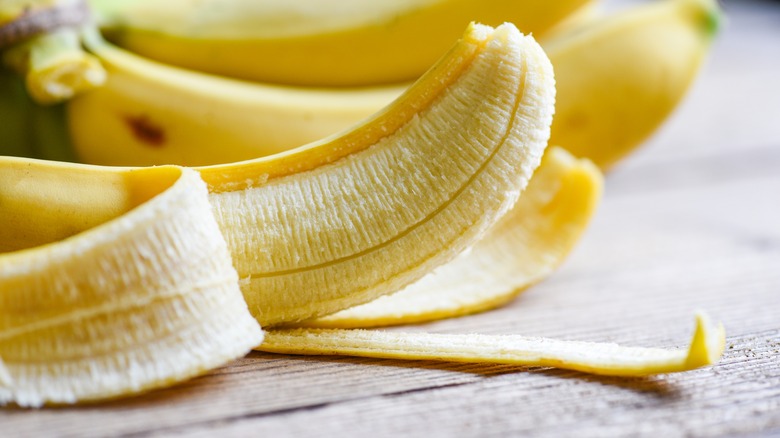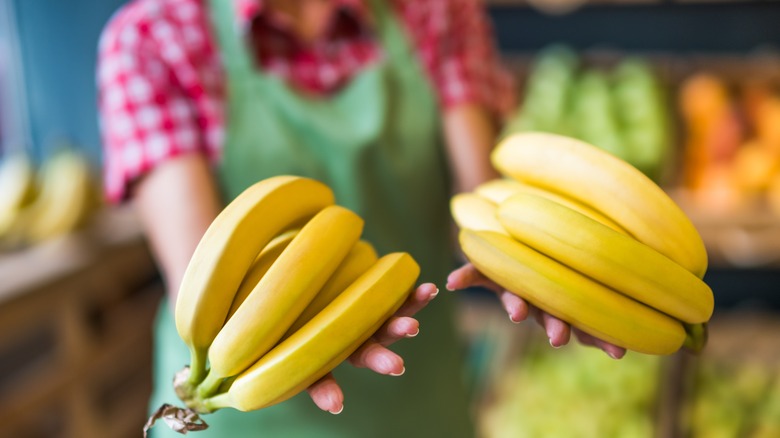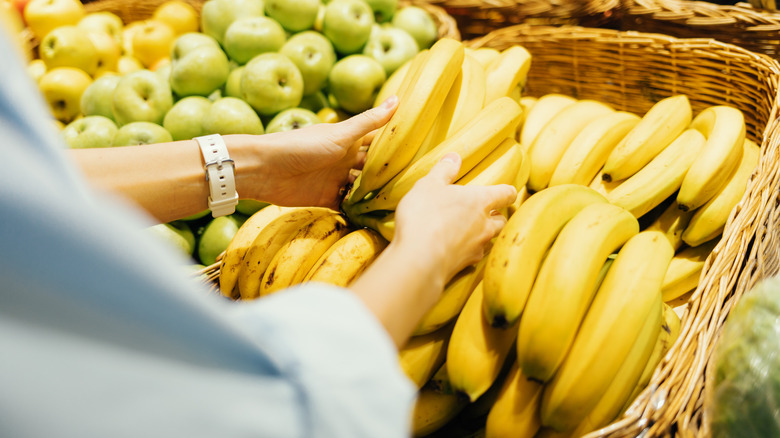Are Trader Joe's 19-Cent Single Bananas Actually Cheap?
Americans love bananas. We've been consuming them regularly since the fruits first arrived in the United States in the early 20th century. More than a century later, we still eat more bananas than any other fruit — more than 80% of U.S. homes buy bananas every year. The tropical fruits were recently chosen as the number one produce product at another American favorite — the supermarket chain with the cult-like following, Trader Joe's. The fruits earned the top spot in the Trader Joe's 15th Annual Customer Choice Awards Winners announced earlier this year.
Trader Joe's sells a lot of bananas, and one particular reason that makes them a top seller beyond our century-old love for the fruit: the chain's sticker price of just 19 cents apiece. Rather than pricing them by the pound as most supermarkets do, Trader Joe's has been selling bananas at 19 cents each for 25 years. Is it a bargain? It sounds like a great deal on the surface, but since most of us don't do the math when buying by the pound or single bananas, it's hard to know if we're really saving or if it's just gimmicky supermarket marketing.
Is Trader Joe's banana price a bargain?
So how does the 19 cents per banana compare to per pound pricing? There's one key consideration: weight. Banana weight is reliant on several factors including the type of banana, when it was picked, and its level of ripeness. In the United States, most of the bananas we consume today are the Cavendish variety — that canary yellow, stereotypical banana. It takes about three of those to get a pound of bananas. The average cost of bananas in the United States is about 63 cents – making it about 21 cents per banana. Whole Foods Market sells a pound of bananas for 69 cents. If you're getting three bananas in that pound, the price is about 23 cents each. In either of these scenarios, Trader Joe's single banana price is still the cheapest of the bunch.
Trader Joe's has been selling those single bananas at 19 cents each for nearly 25 years without a price increase — even amid inflation. Is a price increase on the way? While the chain hasn't hinted at any price changes, the U.S. Bureau of Labor Statistics says inflation should bring that price per banana up to 35 cents today — which would make it much more expensive than buying bananas by the pound. But we won't tell Trader Joe's if you won't.
Why sell the single banana?
Just like other supermarkets, Trader Joe's used to sell bananas by the pound. But, as any fan knows, Trader Joe's is not like other supermarkets. As the former CEO Dan Bane, explains in the first episode of the podcast Inside Trader Joe's, the chain made the shift to per-banana pricing in the '90s. Before that, wanting to avoid placing scales in stores, Trader Joe's weighed and prepackaged bundles of bananas at their warehouses before shipping them to stores. But when Bane asked an elderly customer why she decided not to buy a pack of bananas and received the cheeky reply, "Sonny, I may not live to that fourth banana," he realized that selling them individually would make customers' lives easier. The chain listened and shifted to the simpler, more budget-friendly model of per-banana pricing, and they've been 19 cents since.
A hand (the formal name for the banana cluster) can often contain six or more bananas. While Trade Joe's funny customer was playfully joking about her age, we think the bigger issue for that customer and most banana lovers (who have a preferred stage of ripeness) is that prepackaged bananas leave too many bananas on either side of that short window. While there are many yummy uses for overripe bananas, Trader Joe's side-stepped the issue by encouraging consumers to break the cluster and take only as many bananas as they want in the name of convenience — even if the chain is losing a bit of money on its pricing model.


